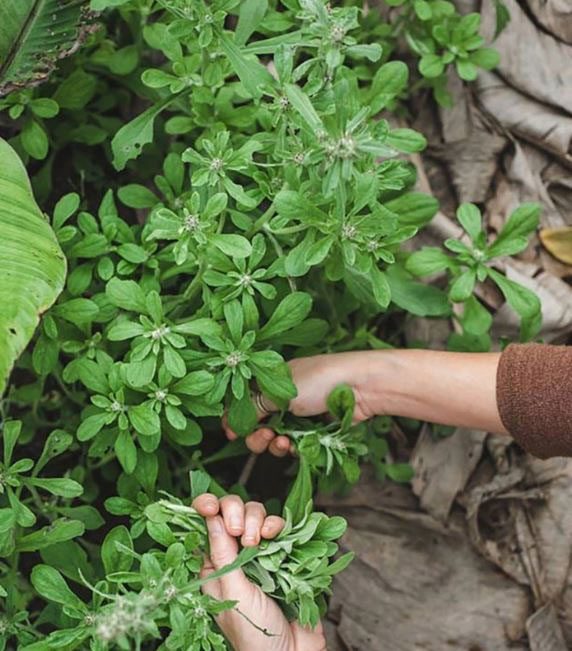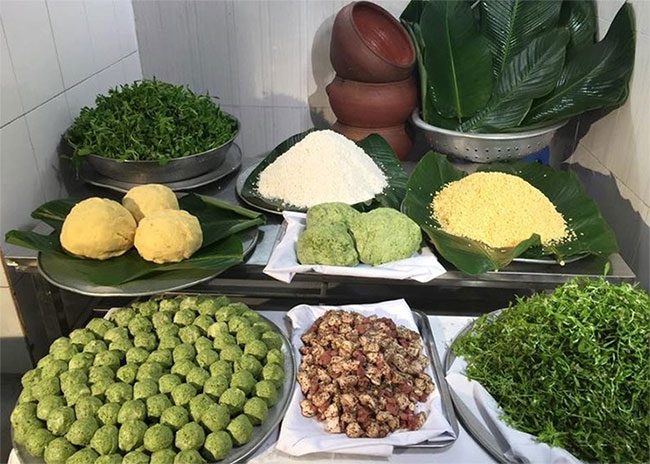This special type of grass is not only used as food but also has medicinal properties; it is becoming increasingly rare, hence its high price.
There is a type of vegetable that cannot be cultivated or cared for, growing wild in rice fields, along dikes, and hidden among decomposing straw. When the rice harvest ends, it resembles more of a “weed” than a vegetable. Its stems and leaves are covered with a silky white fuzz, making it very smooth to the touch. This is Khúc vegetable.
In spring, this peculiar vegetable appears in abundance. Seeds from the previous year lie dormant in the soil, and when spring rains come, they sprout naturally, forming dense clusters around freshly harvested straw.

Khúc Vegetable.
Khúc vegetable is easily confused with weeds in the fields.
In the past, it is unclear whether due to natural rice farming methods, fresh air, or a balanced ecosystem, Khúc vegetables grew abundantly in fields; once one batch was harvested, another would sprout. Elders recount that in spring, women would go out to gather Khúc to make sticky rice or soup; there was so much that they would only select the medium rice cakes (neither too young nor too old), while the older stems were tossed outside for ducks and chickens to eat, “to keep their stomachs cool.”
Now, Khúc vegetables are much rarer, and people have to hunt for them, place orders in advance, and schedule their purchases, hoping to get some. On e-commerce platforms, people even sell frozen Khúc vegetables, vacuum-sealed, costing about 45,000 – 50,000 VND per 100 grams, which is definitely not cheap.
Both regular and sticky Khúc can be used for cooking. Regular Khúc is often used in soups, while sticky Khúc is used for making sticky rice cakes. However, given its rarity, it’s difficult to be picky; as long as it’s fresh and in season, it’s a blessing.

Ingredients for making Khúc cake, simple but memorable in taste.
This humble, small weed is cherished for being an essential ingredient in sticky rice with Khúc. This dish is popular but also intricate to prepare, which is why it is considered a specialty of Hanoi and Northern Vietnam.
The Khúc leaves must be washed thoroughly, pounded into a paste, and then mixed with glutinous rice flour to create the dough. Some people use only the juice, while others include the stems and leaves for added aroma; each method has its own unique flavor. The mung beans used as filling should be of the golden heart variety, soft and fragrant. The meat chosen is usually fatty pork belly, marinated with pepper, salt, and more.
Each piece of glutinous rice dough mixed with Khúc leaves is flattened out, filled with mung bean and meat filling, then wrapped up to the size of a small child’s fist. They are placed in a steamer, rolled in a thin layer of glutinous rice, and then steamed until the rice grains perfectly adhere to the fragrant, translucent cakes, with their delicious aroma wafting through the air.
The ideal result is when the outer layer of sticky rice is pure white, while the soft cake inside is a vibrant green from the Khúc leaves, embracing the golden filling of mung beans and the fatty meat marinated with spicy pepper, melting in your mouth. It feels like the essence of traditional flavors converging here.
Today, due to the rarity and high cost of Khúc leaves, it is difficult for people to enjoy this dish in its original form. Many vendors claim to sell sticky rice with Khúc, but in reality, they often substitute it with old cabbage leaves, spinach, chrysanthemum leaves, or pandan leaves just for color, which cannot replicate the authentic taste.
Not only in Vietnam, but several East Asian countries also consume Khúc vegetables. In Japan, there is a tradition of eating porridge made with seven types of vegetables, including Khúc, on the seventh day of the new year for good health throughout the year.
In Taiwan, there is also a delicious cake made with Khúc that grows in the Alisan mountains, similar to Khúc cake, where only the Khúc leaves are pounded, mixed with glutinous rice flour, wrapped around filling, and then steamed.
Sometimes, people eat Khúc leaves simply boiled as a vegetable.
Khúc is also known by other poetic names such as “Buddha’s Ear Grass” and “Tomb-Sweeping Grass.” According to traditional Chinese medicine, Khúc has a sweet and slightly bitter taste, is neutral, non-toxic, and enters the respiratory system. It has effects on phlegm reduction, relieving wind-cold, treating cough with phlegm, asthma, cold with fever, joint pain, white discharge, abscesses, and boils… Even though Khúc has become rare and expensive, it still grows spontaneously somewhere, purchased during spring to be cherished and turned into nostalgic dishes. From a humble weed, it has become a delicacy for city dwellers. |




















































